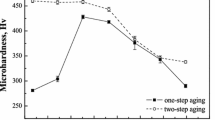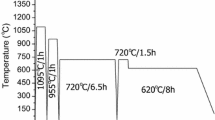Conclusions
Several relationships were found between the original aging and the mechanical properties of plates and slabs of alloy AK4-1 in tests of the long-term strength, elongation, and fracture toughness after prolonged holding at 135 and 150°C (below the artificial aging temperature) under tensile stress.
Under these conditions the naturally aged slabs and also plates and slabs aged 6, 7, and even 12 h at 190–195°C undergo additional aging consisting of additional decomposition of the solid solution, precipitation of hardening phase, and an increase of the density of the precipitates. As the result of this the long-term strength of the less-aged plates and slabs at testing temperatures of 135 and 150°C exceeds that of the plates and slabs aged at 190–195°C for 12 h, although the long-term ductility is considerably lower.
Preliminary holding at 135 and 150°C under tensile stress increases σb and σ0.2. After holding under stresses of 24 and 22.5 kg/mm2 for up to 0.9 of the average time to failure these characteristics remain at their original levels or exceed them. The ductility characteristics (δ and ψ) decrease after holding under stress, particularly for samples aged naturally. The same is true for the fracture toughness and the work of fracture for samples with started cracks. However, with increasing holding time they become almost identical after all aging conditions. The effect of additional aging increases with an increase of the stress during holding.
Similar content being viewed by others
Literature cited
Collection: Aluminum Alloys, No.5, I.N. Fridlyander (editor) [in Russian], Metallurgiya, Moscow (1968).
L. P. Luzhnikov, Deformable Aluminum Alloys for Operation at Elevated Temperatures [in Russian], Metallurgiya, Moscow (1965).
I. N. Fridlyander, High-Strength Deformable Aluminum Alloys [in Russian], Oborongiz, Moscow (1960).
V. I. Dobatkin, K. N. Krupenina, and Z. N. Chernykh, in: Aluminum Alloys [in Russian], Oborongiz, Moscow (1955).
Additional information
Khar'kov Institute of Mechanization and Electrification of Agriculture. Translated from Metallovedenie i Termicheskaya Obrabotka Metallov, No. 8, pp. 45–50, August, 1969.
Rights and permissions
About this article
Cite this article
Kosarev, A.I., Bich, É.N., Kryuchkova, A.P. et al. Properties of the AK4-1 alloy after additional aging under stress. Met Sci Heat Treat 11, 635–638 (1969). https://doi.org/10.1007/BF00652121
Issue Date:
DOI: https://doi.org/10.1007/BF00652121




